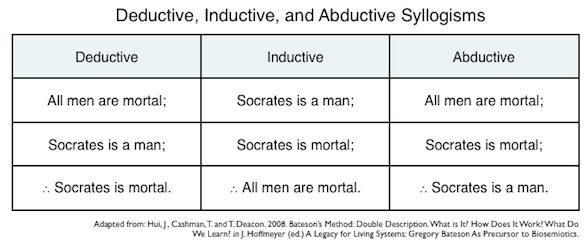Organizational and social innovation cannot happen without the emergence of novel practices, norms, and other institutions. In a word: creativity.
But how well is creativity understood, and to what extent can it be described as a process of abductive reasoning? — as referenced in recent talks and articles by Roger Martin in Design Observer, Carl Steinitz at the GeoDesign Summit, Jon Kolko in Stanford Social Innovation Review, and Dan Berrett in The Chronicle of Higher Education.
“The abductive suggestion comes to us like a flash. It is an act of insight, although of extremely fallible insight,” wrote philosopher and logician Charles Sanders Peirce.
“The very possibility of abduction is a little uncanny,” marveled cyberneticist Gregory Bateson, “and the phenomenon is enormously more widespread than [one] might, at first thought, have supposed.”
Here’s how Peirce outlined the process in 1903: “The surprising fact, C, is observed; But if A were true, C would be a matter of course; Hence, there is reason to suspect that A is true.”
For example: I observe that birds can fly; But if the magic of flight were in the wings, then the fact that birds can fly would be a matter of course; Hence, I suspect that the magic of flight is in the wings, and I build a machine with wings to see if it enables me to fly.
Abduction, as defined in The Compact Oxford English Dictionary: “A syllogism, of which the major premiss is certain, and the minor only probable, so that the conclusion has only the probability of the minor.”
In an 1878 essay, Peirce referred to this process as hypothesis making, a form of synthetic inference along with — yet distinct from — the process of induction.

Here is a comparison of syllogisms, adapted from Julie Hui, Tyrone Cashman, and Terrence Deacon.

And here is a comparison of processes, adapted from Hans Rudi Fischer. Solid boxes contain premises that are presupposed as true; dashed boxes contain premises that are inferred.

Worth noting: In addition to the terms hypothesis and abduction, Peirce also referred to this form of reasoning as retroduction — and wrote in 1911:
I do not, at present, feel quite convinced that any logical form can be assigned that will cover all ‘Retroductions’. For what I mean by a Retroduction is simply a conjecture which arises in the mind.
References:
- Bateson, G. 1979. Mind and Nature: A Necessary Unity, p.157.
- The Compact Oxford English Dictionary (Second Edition). 1991.
- Fischer, H. R. 2001. Abductive Reasoning as a Way of Worldmaking. Foundations of Science 6:361–383.
- Hui, J., Cashman, T. and T. Deacon. 2008. Bateson’s Method: Double Description. What is it? How does it work? What do we learn? in J Hoffmeyer (ed.) A Legacy for Living Systems: Gregory Bateson as Precursor to Biosemiotics.
- Peirce, C. S. 1878. Deduction, Induction, and Hypothesis, in N. Houser and C. Kloesel (eds. 1992) The Essential Peirce, Volume 1.
- Peirce, C. S. 1903. Harvard Lectures on Pragmatism, in Collected Papers v. 5, viewed at: http://www.textlog.de/7664-2.html.
- Peirce, C. S. 1911. A Letter to J. H. Kehler, in New Elements of Mathemaatics v. 3, viewed at: http://www.helsinki.fi/science/commens/terms/retroduction.html.

